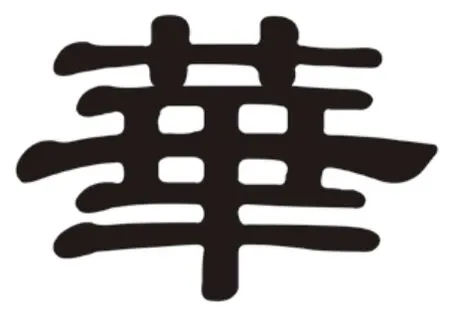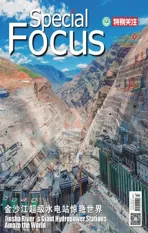Understanding Chinese Characters huā, huá, huà
2019-08-08ByLiHuatian
By Li Huatian
(Vice professor at the School of Foreign Languages,Central China Normal University)
Language is a symbol of culture, and culture revolves around language. As a result, every Chinese character is intimately linked with culture. So it is with the Chinese character 华 (huā,huá, huà).
华 originally meant “blossoming flowers”according toOrigin of Chinese Characters, but was subsequently extended to mean “prosperous”or “splendid,” and finally refers to the Chinese nationality in general. It embodies the aesthetic spirit of Chinese people's love of beauty, as well as the colorful resplendence of Chinese culture.
This character has a history of more than 3000 years since its origin in Oracle Bone Script. It appeared in the Shang Dynasty (1600 BC-1046 BC),the first dynasty with written records in China's history. Over the passage of time the number of strokes was reduced resulting in the present form华.

Take a close look at the Oracle Bone Script and Bronze Script (the two earliest) forms of 华,we'll find different horizontal lines represent the fiourishing tree branches and blossoming fiowers or plentiful fruits, while the main vertical line signifies the tree trunk and other minor vertical lines stand for branches. This character had been widely used in classical Chinese masterpieces. For instance, inThe Book of Poems:Peach, “The peach trees are in full bloom, brilliant and radiant.” (桃之夭夭 ,灼灼其华。—《诗经·桃夭》。) And inPlain Questions of Yellow Emperor's Classic of Internal Medicine,“Those whose pulse is as weak as a flower are so frightening that we should take care of them.” (脉至如华者,令人善恐。—《黄帝内经·素问》。)
This pronunciation of “huā” and its meaning as “flower” are seldom used in the daily life of Chinese people today, but we may still come across it occasionally in phrases, such as 华 英 (huāyīng,blossoming fiowers), and 华 叶 (huāyè, fiower and leaf), or as a verb in 桃李始华 (táo lǐ shǐ huā, peaches and plums begin to blossom).
As time passed, the character华 has developed many different connotations, while its pronunciation as “huá” became the most common in daily use.
We can still perceive its original meaning,blossom, in some old idioms such as 春华秋实(chūn huá qiū shí, fiower in spring and yield fruit in autumn) and 华 而 不 实 (huá ér bù shí, produce flowers but bear no fruit; flashy; style over substance), though its pronunciation has changed from “huā” to “huá.”

甲骨文Oracle Bone Script

金文Bronze Script

篆书Seal script

隶书Clerical Script

楷书Regular Script

行书Semicursive Script
From the transformation of the character as they appeared in each historical epoch, it is plain to see that the transformation of Chinese calligraphic stylings from seal script, clerical script, regular script, to semicursive script was determined by graphical characteristics such as strokes, shapes, structures and derivations.
Probably because flowers of all kinds are a beautiful sight and the season in which they blossom is the perfect time,华 (huá)are now more often associated to something “magnificent,”“gorgeous,” “prosperous” and“splendid,” which is its figurative meaning, and is so widely used that it appears in a gaggle of different phrases: 华 丽 (huálì,magnificent), 华 彩 (huácái,resplendent or rich color), 繁华(fánhuá, fiourishing), 荣 华 富 贵(rónghuáfùguì, wealth and high rank), 华章 (huázháng, beautiful poetry), etc.
In addition, it is just due to the beautiful season when everything is in bloom that华 (huá) takes on its derivative meaning of “proper time,” “age” or “special gift.”Take a look at these phrases: 年华(niánhuá, time), 韶 华 (sháohuá,prime of youth), 精 华 (jīnghuá,essence), 才华 (cáihuá, literary or artistic talent).
But an overabundance of flowers will become garish and even hard on the eyes, so the character 华 (huá) derives yet another meaning of “luxurious”or “sumptuous,” which appears in the phrases 豪 华 (háohuá,luxurious), 奢 华 (shēhuá,extravagant), and 浮 华 (fúhuá,showy).
More often than not, the Chinese people have a strong affinity for the character 华(huá) and use it to reference the Chinese people themselves or as an abbreviation for the People's Republic of China. So the following phrases have an underlying social and ethnic connotations: 中 华 (zhōnghuá,China), 华夏 (huáxià, China), 华裔 (huáyì, ethnic Chinese), 华 侨(huáqiáo, overseas Chinese), 华中 (huázhōng, Central China),华 胄 (huázhòu, descendants of Chinese, esp. nobles).
Lastly, when this polyphonic character is pronounced in the fourth tone “huà,” it usually becomes part of a proper name: Referring either to华山 (huàshān, Mt. Huashan)in Shaanxi Province or to the surname Huà, such as华元 (huà yuán, the scholar-officials of the State of Song during the Spring and Autumn Period ), 华佗 (Huà Tuó, a famous doctor in the Han Dynasty), 华蘅芳 (Huà Héngfāng,a famous mathematician in the Qing Dynasty), and华 罗庚 (Huà Luógēng, a modern mathematician and educator).
One can't help but notice that this simple character paints a picture of the culture and history of China that is as vivid and resplendent as the blooming blossoms the character itself was based upon. So as a Chinese language learner, it is necessary to become familiar with all the diverse meanings of this simple yet bedecked and altogether aweinspiring word.
